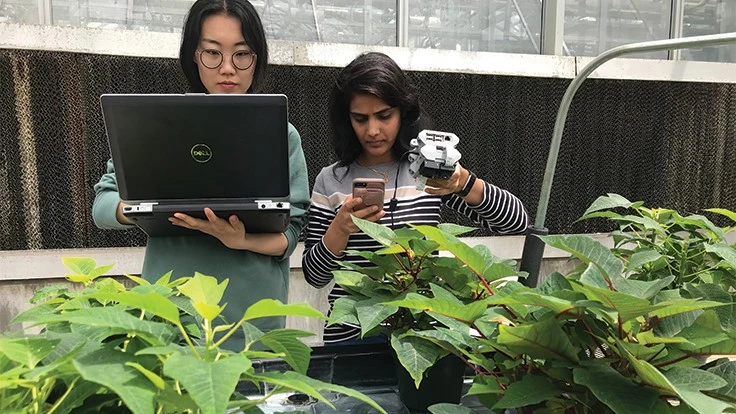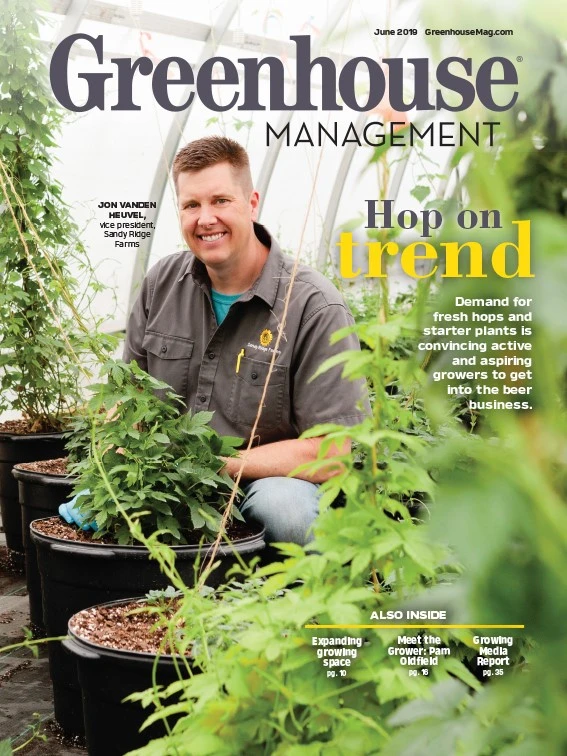
_fmt.png)
Your smartphone may be a distraction from greenhouse duties — or perhaps it’s a way to productively check email or complete general business-type tasks. Usually, you would not use it as a tool to monitor plant nutrition levels. But now, that is changing, as researchers are working on a way for growers to use their smartphone to measure plant nitrogen.
Krishna Nemali, assistant professor of controlled environment agriculture at Purdue University, is working with this technology. Using a microcontroller (small computer) called a Raspberry Pi attached to cameras, filters and a casing, and either a smartphone or computer, he says a grower will soon be able to affordably take photos of multiple plants at once and receive a quick reading of how much nitrogen is in them.
“We use actually two cameras with nitrogen measurement because we are picking crop signature,” Nemali says. “People say ‘crop signature,’ but it’s basically what plants are telling us — they’re talking to us in a different language. We are picking up that signature and using the signature, we can actually indirectly measure how much nitrogen is there in the plant.”

The evolution of nitrogen measurement
By measuring nitrogen and applying proper nitrogen amounts, Nemali says growers can keep their plants healthy, save money on fertilizers and be responsible to the environment by avoiding runoff.
“What matters is, at the end of the day, how much of that fertilizer ends up in the plant — not how much you supply to the fertilizer solution, not how much is in the substrate — but what is inside the plant is what matters because that is what is used in the growth and making a good-quality plant,” Nemali says.
He points out there are currently four generations of techniques growers use to measure nitrogen.
The first generation is simple. “You’re walking and you’re looking at these plants; ‘Oh, these plants are small.’ You’re sensing something visually,” Nemali says. “But there are a lot of errors associated with that.”
The second generation involves cutting and harvesting plants and sending them to laboratories. It could take seven to 10 days for those labs to return results and multiple samples are often required at $20 to $25 per sample.
The third generation includes electrical conductivity sensors, quantum sensors and other technologies that are both useful and popular, Nemali says. But growers can only measure one pot at a time.
Enter the fourth generation. “Now, we are moving into something called remote-sensing — plant-based, imaging-based sensors,” Nemali says. “This is the most advanced sensing, and I think our industry needs this, and that’s what I am after.”

Remote sensing
Purdue’s devices, which include cameras, Raspberry Pis and other accoutrements, will likely cost about $150. Nemali says this price is well within the range of what studies show many people are willing to pay for beneficial technology.
Following their purchase of one or more devices, growers can manually take photos as they walk through the greenhouse, from multiple stationary devices around the operation or from irrigation booms and other moving objects.
From there, growers can send photos to a smartphone or computer. Currently, Purdue University uses a server to process the images and estimate nitrogen levels in plants, then sends the information back to the growers’ smartphones or computers.
“They can actually take these measurements as many times as they want in a day or every day,” Nemali says. “It’s just like taking a picture and sending it to someone, like texting an image.”
Compared to laboratory analysis of nitrogen content, the researchers are getting similar nitrogen reads through image-based estimation.
They can actually take these measurements as many times as they want in a day or every day. It’s just like taking a picture and sending it to someone, like texting an image. — Krishna Nemali
“What we are seeing is that there is a near-lineal relationship,” Nemali says.
The university developed algorithms to estimate the amount of nitrogen in plant tissues, by using hundreds of samples from bedding plant and poinsettia species.
In the future, Purdue will also develop an app for growers to estimate nitrogen content and bypass the need for a server, Nemali says. Using the app, growers will select a species — at times, a specific variety, get a reading of the amount of nitrogen in the tissues of their plants and fertilize the right amount of the nutrient to their crop.
The Horticultural Research Institute, American Floral Endowment and Fred C. Gloeckner Foundation are all funding Nemali’s project, which he notes is not typical. All three groups are large and focused on applied research, which Nemali says indicates that the greenhouse industry is looking for smartphone-based technologies.
Most of the funding from the Gloeckner Foundation went toward working on algorithms and software for poinsettia nitrogen estimation. AFE funding is going toward developing models and algorithms for bedding plants and 2019 HRI funding is being spent to build devices and distribute them to growers.
In 2019 and into 2020, Purdue will perform beta testing on the project. Growers will need a smartphone with mobile data to participate in beta testing, and they will receive the additional hardware at no cost.
“We are looking for some of those growers who are really into technology — it doesn’t matter what scale it is — but who can actually collaborate with Purdue all over the country,” Nemali says.

Explore the June 2019 Issue
Check out more from this issue and find your next story to read.
Latest from Greenhouse Management
- 2025 Proven Winners Horticulture Scholarship applications now open
- How to improve inventory and shipping management in the greenhouse
- Leading Women of Horticulture: Anna Ball, Ball Hort, and Terri McEnaney, Bailey Nurseries
- GM CEA HERB Part 2: A guide to increasing the sowing density of culinary herbs
- GM CEA HERB Part 1: Best practices for producing culinary herbs in controlled environments
- USDA fires experts on invasive pests, including Asian citrus psyllid, chilli thrips
- CEA Alliance celebrates bipartisan introduction of Supporting Innovation in Agriculture Act
- Dümmen Orange North America celebrating 25th anniversary in 2025






